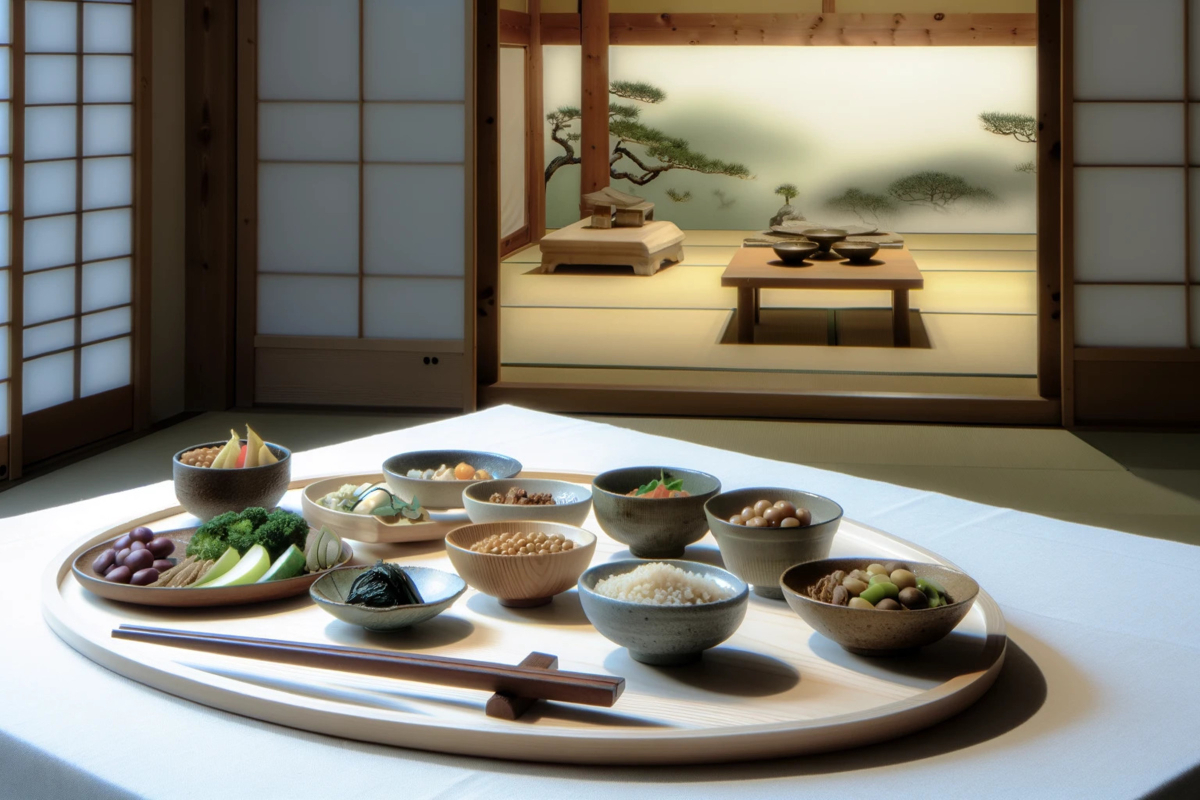
Craving a taste of Japan? Dive into Kyoto’s culinary scene with our list of famous foods in Kyoto. From savory street snacks to exquisite traditional dishes, get ready to tantalize your taste buds with each flavorful bite. Discover why Kyoto is a foodie paradise, where every meal is an adventure waiting to be savored.
In this mouth-watering listicle, we’ll delve into the must-try delicacies that define Kyoto’s gastronomic landscape. Whether you’re a ramen enthusiast, sushi aficionado, or dessert lover, there’s something for everyone on this delectable journey through Kyoto’s iconic flavors. Scroll down for reviews of our top picks and embark on a culinary exploration like no other.
Key Takeaways
- Delve into the rich culinary tradition of Kyoto by trying famous dishes like Kaiseki Ryori, Yudofu, Matcha Sweets, Kyoto-style Sushi, Shojin Ryori, Tsukemono, Kyo-Kaiseki, Yatsuhashi, Wagashi, and Obanzai Ryori.
- Experience the artful and seasonal multi-course meal of Kyo-Kaiseki that showcases Kyoto’s finest ingredients and culinary techniques.
- Treat yourself to the unique and delightful flavors of Matcha Sweets, a fusion of traditional Japanese sweets with the essence of matcha.
- Appreciate the simplicity and purity of yudofu, a tofu-based dish that highlights the delicate flavors and textures of Kyoto cuisine.
- Embrace the cultural significance of wagashi, traditional Japanese confections that reflect the changing seasons and artistic craftsmanship.
- From the pickled vegetables of Tsukemono to the intricate flavors of Kyoto-style sushi, Kyoto’s culinary landscape offers a diverse range of tastes to explore.
10 Famous Foods In Kyoto

1. Kaiseki Ryori
A traditional multi-course meal in Kyoto, Kaiseki Ryori [1], is a culinary experience that embodies the essence of Japanese cuisine. This dining tradition focuses on using seasonal and local ingredients to create dishes that reflect the flavors of each season.
The meticulous preparation and artistic presentation of Kaiseki Ryori elevate it beyond mere food; it becomes a form of edible art. Each dish is carefully crafted to not only delight the taste buds but also appeal to the eyes, showcasing a harmonious blend of colors, textures, and flavors.
By emphasizing seasonal ingredients, Kaiseki chefs ensure that diners experience the freshest produce at its peak flavor. The changing menu throughout the year allows guests to savor different tastes depending on the seasons they visit Kyoto.
This attention to detail and respect for nature’s bounty make Kaiseki Ryori a culinary journey that celebrates Japan’s rich food culture while offering an unforgettable gastronomic adventure for those fortunate enough to partake in this exquisite dining experience.
2. Yudofu
Yudofu is a tofu hot pot dish that holds a special place in Kyoto’s culinary scene. Its simplicity belies the delicate flavors it offers, making it a favorite among locals and visitors alike. This dish shines, particularly during the winter season, providing warmth and comfort.
In Kyoto, yudofu is not just a meal; it’s an experience steeped in tradition and history. The city’s deep connection to this dish makes enjoying yudofu more than just tasting food—it’s like taking a bite out of Kyoto itself. The light yet flavorful broth used in preparing yudofu encapsulates the essence of this ancient capital.
For those looking to immerse themselves fully in Kyoto’s local cuisine, trying yudofu is an absolute must-do. Its unique preparation method and distinctive taste make it stand out as one of the great dishes representing the cultural richness of this historic city.
3. Matcha Sweets
Kyoto, renowned for its matcha desserts, offers a delightful array of green tea-flavored treats that captivate the taste buds of locals and tourists alike. Indulge in the creamy goodness of matcha ice cream, or savor the layers of flavor in a decadent matcha parfait.
The distinct appeal of these sweets lies in their rich, earthy flavors with a subtle hint of bitterness, creating a unique taste experience that sets them apart from other traditional desserts. The use of high-quality matcha powder enhances not only the color but also the depth of flavor in these delectable creations.
Whether you’re enjoying a simple matcha latte or exploring more elaborate confections like matcha cakes and cookies, each bite provides a harmonious blend of sweetness and umami notes characteristic of this beloved Japanese ingredient.
The intricate balance between sugar and the bold flavors derived from premium matcha leaves ensures an unforgettable culinary journey through Kyoto’s vibrant food scene.
4. Kyoto-style Sushi
Kyoto-style sushi stands out for its unique approach to this traditional Japanese dish. Unlike typical sushi, Kyoto-style sushi emphasizes simplicity and elegance in both presentation and taste.
- The sushi in Kyoto features fresh ingredients sourced locally from the Sea of Japan, ensuring a delightful burst of flavors that are distinct to the region.
- One notable characteristic is the lightly seasoned rice used in Kyoto-style sushi, which allows the natural tastes of the fish and other toppings to shine through.
- Delicate toppings like kamaboko (fish cake) or kelp add layers of texture and flavor to each piece, creating a harmonious blend with the rice.
This culinary experience captures not just a meal but also reflects Kyoto’s rich food culture. Each bite tells a story of tradition and innovation intertwined seamlessly on your plate.

5. Shojin Ryori
Buddhist vegetarian cuisine in Kyoto is known as Shojin Ryori, a culinary tradition deeply rooted in mindfulness and simplicity. This type of food reflects a profound respect for nature by utilizing fresh, seasonal ingredients to create dishes that are not only visually appealing but also nourishing.
Shojin Ryori emphasizes the natural flavors of its ingredients, often incorporating elements like sansho pepper to enhance taste without overshadowing the innate essence of the dish. The focus on minimalism allows diners to experience the purity and authenticity of each component, showcasing the artistry behind this unique style of cooking.
In Kyoto’s historic Gion district, where tradition meets modernity, visitors can savor various varieties of Shojin Ryori prepared with meticulous attention to detail. From delicate vegetable tempura to hearty tofu-based dishes, each offering provides a glimpse into centuries-old culinary practices that continue to captivate both locals and tourists alike.
6. Tsukemono
Traditional Japanese pickles are a must-try in Kyoto, offering a delightful blend of flavors to complement any meal. These pickles are crafted from an array of ingredients like vegetables, fruits, and even flowers, showcasing the diversity and creativity of Kyoto’s culinary scene. The process involves fermenting these items with salt, vinegar, or soy sauce to achieve that distinct tangy taste.
Tsukemono adds a unique touch to dishes by providing a burst of acidity and crunchiness that balances out rich flavors. In Kyoto, these pickles often accompany traditional meals like rice bowls or bento boxes as palate cleansers between bites. They serve not only as flavor enhancers but also as aids to digestion due to their probiotic properties.
Moreover, tsukemono comes in various styles, ranging from sour umeboshi plums to crunchy cucumber pickles. This variety ensures there is something for every palate preference when exploring the world of Japanese pickles in Kyoto’s food scene. So next time you’re dining in Kyoto, don’t miss out on trying these flavorful and colorful additions that have been enjoyed for centuries.
7. Kyo-Kaiseki
Kyo-Kaiseki is the high-end version of kaiseki ryori that is unique to Kyoto, Japan. It serves as a culinary masterpiece showcasing the city’s rich heritage and culinary craftsmanship.
The presentation of Kyo-Kaiseki is nothing short of artistry, with meticulous attention given to every detail on the plate. Each dish not only delights the palate but also tells a story of Kyoto’s culture and tradition through its flavors and aesthetics.
This traditional dining experience goes beyond just food; it immerses diners in an exploration of Kyoto’s history and seasonal ingredients. The chefs behind Kyo-Kaiseki are like artists, carefully selecting each element to create a harmonious symphony of taste and visual appeal.
8. Yatsuhashi
Yatsuhashi is a renowned traditional sweet hailing from Kyoto, Japan. These delicate treats are thin, cinnamon-flavored rice flour cookies that have captivated locals and tourists alike for generations.
These delectable sweets come in various flavors to cater to different preferences. From the classic cinnamon taste to unique options like matcha and strawberry, there’s a yatsuhashi flavor for every palate.
Yatsuhashi holds cultural significance beyond its delicious taste; it symbolizes Kyoto’s rich culinary heritage and craftsmanship. The meticulous preparation of these treats showcases the dedication to preserving traditions in Japanese cuisine.
Visitors often seek out yatsuhashi as souvenirs due to their popularity and distinctive Kyoto charm. Whether enjoyed fresh or brought home as gifts, these sweets encapsulate the essence of Kyoto’s culinary delights.
9. Wagashi
Traditional Japanese confectionery in Kyoto, Wagashi, represents a blend of art and taste. These beautifully crafted sweets are not just desserts but also cultural symbols deeply rooted in Japanese traditions.
Wagashi is often served during tea ceremonies as a symbol of hospitality and respect for guests. The intricate designs and vibrant colors make them visually appealing, enhancing the overall experience.
Made with natural ingredients like red bean paste and mochi, Wagashi offers a unique flavor profile that balances sweetness with subtle hints of savory elements. This harmonious combination reflects the delicate balance valued in Japanese cuisine.
These delicacies are meticulously prepared by skilled artisans who have mastered the techniques passed down through generations. Each piece of Wagashi tells a story through its design, flavors, and textures.
In Kyoto, experiencing Wagashi goes beyond mere indulgence; it’s an immersion into centuries-old culinary craftsmanship that continues to captivate locals and tourists alike. The next time you visit Kyoto, don’t miss the chance to savor these exquisite delights!
10. Obanzai Ryori
Home-style cooking in Kyoto reflects the heart of Obanzai Ryori, a culinary tradition deeply rooted in the region’s culture. This cuisine emphasizes using local, seasonal ingredients to create dishes that are both flavorful and sustainable.
Obanzai chefs take pride in their ability to minimize waste by making use of every part of an ingredient, showcasing their respect for nature and resourcefulness. The result is a menu filled with comforting dishes that offer a taste of Kyoto’s rich food heritage.
With recipes passed down through generations, Obanzai Ryori embodies a sense of community and tradition. Each dish tells a story of Kyoto’s past while embracing modern culinary techniques to cater to contemporary tastes. Whether it’s simmered vegetables or grilled fish seasoned with local spices, every bite encapsulates the essence of this beloved cuisine.

Summary
You’ve now got the inside scoop on the famous foods in Kyoto. From the delicate flavors of Kaiseki Ryori to the traditional Yudofu, and the sweet indulgence of Matcha Sweets, Kyoto’s culinary scene is a feast for all your senses.
Don’t miss out on trying Kyoto-style Sushi, the vegetarian delights of Shojin Ryori, or the vibrant pickled flavors of Tsukemono. Dive into the refined tastes of Kyo-Kaiseki, savor the iconic Yatsuhashi, and indulge in Wagashi and Obanzai Ryori.
Ready to embark on a culinary adventure through Kyoto? Grab your chopsticks and get ready to explore the diverse and exquisite flavors this historic city has to offer. Let your taste buds be your guide as you discover the essence of Kyoto through its renowned dishes.
Frequently Asked Questions
What is Kaiseki Ryori?
Kaiseki Ryori is a traditional multi-course Japanese meal that showcases seasonal and regional ingredients in an artful presentation. It’s like experiencing a symphony of flavors where each dish harmonizes to create a culinary masterpiece.
Where can I try Yudofu in Kyoto?
You can savor the simple yet flavorful tofu hot pot dish, Yudofu, at specialized restaurants or traditional ryokans in Kyoto. The dish highlights the purity of the tofu and how it absorbs the essence of the accompanying broth.
What are Matcha Sweets?
Matcha sweets are delectable treats infused with finely ground green tea powder, offering a balance of bitter and sweet flavors. Indulge in matcha-flavored desserts like cakes, ice cream, and mochi for an authentic taste of Kyoto’s culinary culture.
How does Shojin Ryori differ from other cuisines?
Shojin Ryori is a vegetarian Buddhist cuisine that emphasizes simplicity, seasonality, and mindfulness. Unlike other cuisines rich in meat-based dishes, Shojin Ryori focuses on plant-based ingredients prepared with meticulous attention to detail for both nourishment and spiritual fulfillment.
Can you explain what Tsukemono is?
Tsukemono refers to Japanese pickles made by fermenting vegetables like radish or cucumber in salt, vinegar, or soy sauce. These pickles serve as palate cleansers between courses or condiments that add vibrant colors and refreshing tanginess to meals in Kyoto.




